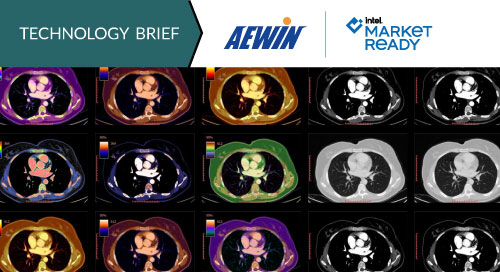AI and Machine Learning Transform Cancer Treatment

Screening for lung cancer—the second-most common type of cancer worldwide—is a complex process. Doctors use Low-Dose Computed Tomography (LDCT) to scan patients and produce hundreds of 2D images. Physicians review them to identify the location and volume of tumors, which they then evaluate in context of the patient’s medical history, lab work, biopsies, and other information, all of which help determine the stage of the illness and the best course of treatment.
LDCT is an essential tool in fighting the deadly disease, but it’s also a slow, painstaking process that leaves room for manual error. A new approach uses edge processing, AI, and secure data sharing to help doctors arrive at an accurate diagnosis much faster and start treatment sooner. Over time, it could improve understanding of lung cancer and other diseases, and spur development of more effective therapies.
As medical #AI #technology improves screening efficiency, suspected cancers can be identified earlier prompting treatment #workflow to begin sooner. @IPC_aewin via @insightdottech
Elevating Rates of Detection
The LDCT AI assistant solution, developed by network hardware and edge server producer AEWIN Technologies Co., Ltd., uses three advanced technologies in concert to produce faster results. The most important is fast computing power. Based on 3rd Gen Intel® Xeon® Scalable Processors, the AEWIN SCB-1932C edge server can process hundreds of LDCT images on-site in near-real time.
“To process that many images, the CPU must be extremely powerful,” says Benjamin Wang, Director of Sales and Marketing at AEWIN. “And some Intel® chips also contain built-in security features to help protect medical data from hackers.”
The AI assistant platform uses the Intel® OpenVINO™ Toolkit to analyze patient LDCT images. Through large amounts of scans the system can quickly reduce the number of images—from up to 600 to just a handful—a doctor needs to consider.
“AI applies inference to detect abnormal lung nodes and categorize them, so doctors only have to examine high-priority scans, which helps to improve the efficiency of the diagnosis,” says Tiana Shao, Product Marketing Manager at AEWIN. “Medical AI architects convert from hundreds of supported AI frameworks that easily run on the AEWIN Edge Computing platform—providing significant improvement in performance.”
As medical AI technology improves screening efficiency, suspected cancers can be identified earlier, prompting treatment workflow to begin sooner. Increasing such availability of AI systems can accelerate development of early-detection solutions and can lower total cost of care.
Improving AI Models
Recently, AEWIN started using a new platform that could increase effectiveness of detection, better predict the course of disease, and lead to improved treatments.
For years, a web of disparate and evolving patient privacy laws has stymied medical professionals’ ability to pool and analyze their data. With the new Qisda Federated Learning Platform, hospitals around the world can securely share important AI model parameters without transmitting any sensitive personal patient information.
This enormous influx of data will greatly benefit AI models, which depend on analyzing vast data sets to improve their capabilities. “With open and secure federated learning running on AEWIN-based IT infrastructure, hospitals can build and scale better models together,” Shao says.
Machine learning also requires diversity to reduce bias. When hospital data is siloed, geographic and demographic range is limited. Even the type of medical instruments doctors use can affect results. AI models on a growing pool of diverse data will result in continuous improvements in accuracy. As AI systems correlate medical procedures with results on a large scale, they will help doctors better understand disease progression and decide which treatments are most effective in various scenarios.
AEWIN plans to deploy the Qisda platform and its smart-imaging solution at two major university hospitals in Taiwan, along with several smaller local facilities. Procurement of new AI infrastructure is often a challenging investment for many medical institutions. Leveraging idle compute on existing IT infrastructure can alleviate high CAPEX for medical AI development. Alternatively, Qisda offers cloud solutions that can be implemented on-premises at medical centers. For local hospitals that can’t afford high-performance equipment, the business model leases the solution instead of buying the whole system.
“Medical AI paves the need for modern business models such as subscription or pay per use,” Wang says.
As AI algorithms ingest more data, small hospitals and their branches will benefit equally from the learning model’s improved accuracy and predictions.
So far, AEWIN uses its system for lung cancer, but use cases are likely to broaden. “Lung nodes can achieve high accuracy of detection with current technology. We take this as a start and look forward to further potential applications,” Shao says. “With the cooperation of various hospitals all over the world, smart healthcare can rapidly evolve. We expect to see many new applications in the next few years.”
This article was edited by Georganne Benesch, Associate Editorial Director for insight.tech.